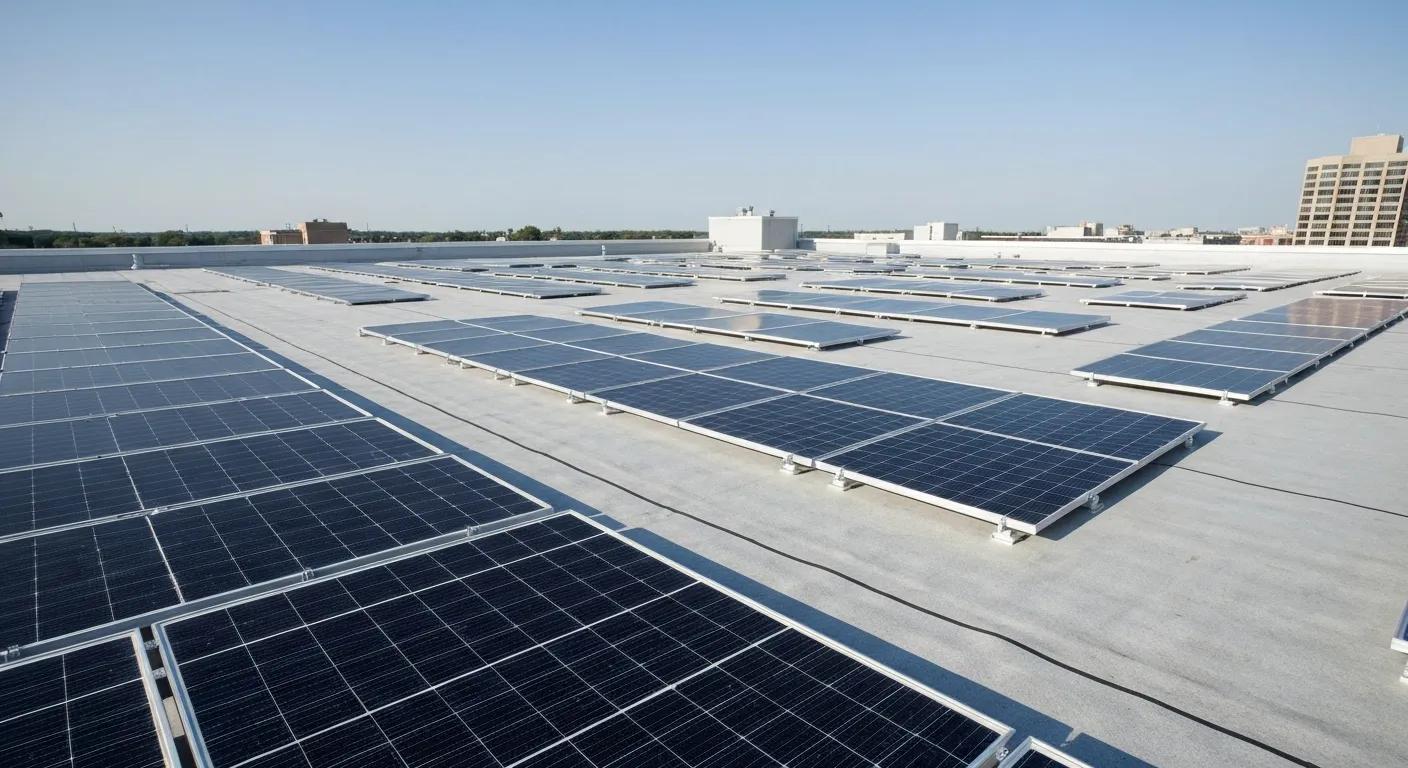
Comprehensive Guide to TPO Commercial Roofing: Benefits, Installation, and System Components
Thermoplastic Polyolefin (TPO) is a single-ply roofing membrane widely used on commercial flat and low-slope roofs because it combines reflective cool-roof performance with seam weldability and ease of installation. This guide explains what TPO roofing is, how it reduces energy loads, why its seam welding and material makeup deliver durability, and how a complete TPO roof system is assembled and maintained for long service life. Building owners and facility managers face rising energy costs, storm exposure, and tight budgets; understanding TPO’s energy, lifecycle cost, and repair characteristics helps decide when to repair, retrofit, or replace a roof. The article walks through the key benefits of TPO, a layer-by-layer breakdown of system components, step-by-step installation checkpoints, comparisons with EPDM, PVC, and metal options, and practical maintenance and repair strategies. Throughout, readers will find actionable checklists, EAV-style comparison tables, and installation and inspection lists that support decision making for commercial roofing projects in climates like Garland, TX and similar sun-exposed regions.
What Are the Key Benefits of TPO Roofing for Commercial Buildings?
TPO roofing delivers a combination of energy efficiency, durability, and cost efficiency that makes it a strong choice for many commercial properties. Its light-colored, reflective surface reduces solar heat gain, lowering cooling demand and improving indoor comfort for facilities with high HVAC loads. The membrane’s thermoplastic chemistry supports heat-welded seams, which produce continuous, watertight joins that help resist leaks and simplify repairs compared with some other single-ply systems. Owners also benefit from relatively fast installation timelines and favorable lifecycle cost profiles when insulation and drainage are properly specified, making TPO a competitively economical option for reroofing and new construction alike.
TPO’s energy advantages are especially relevant in sun-exposed climates where daytime cooling dominates operational costs, and practical installation experience on local roofs confirms those savings when paired with adequate insulation and reflective maintenance. For property managers evaluating roofing options, the next subsection details how reflectivity translates into measurable energy and cost savings.
How Does TPO Roofing Improve Energy Efficiency and Cost Savings?

TPO improves energy efficiency primarily through high solar reflectance and thermal emissivity, which reduce absorbed solar energy and decrease building cooling loads. A properly detailed TPO roof with continuous polyiso insulation and minimal thermal bridging can lower peak cooling demand and reduce HVAC runtime, producing operational savings over the membrane’s life. Savings vary by building type, roof area, and local climate, but owners frequently see meaningful reductions in annual cooling energy on sun-exposed facilities when switching from darker membrane or built-up roofing to reflective single-ply systems. Recent industry analyses and modeling through 11/2025 continue to show that cool roofing strategies paired with adequate R-value insulation produce the largest lifecycle savings when replacement timing and energy price trends are accounted for.
Key factors that affect net savings include the membrane’s reflectivity, insulation thickness and continuity, rooftop equipment density, and maintenance that preserves reflectivity; understanding these variables helps predict ROI for commercial projects.
- TPO reduces solar heat gain through reflectivity and emissivity.
- Insulation continuity and thickness determine net HVAC savings.
- Maintenance that preserves surface reflectivity sustains savings over time.
These three factors—material reflectivity, thermal assembly, and maintenance—explain why energy modeling is a critical step before committing to a reroof project.
What Makes TPO Roofing Durable and Weather-Resistant?
TPO’s durability arises from its polymeric formulation, UV stability additives, and the use of welded seams that minimize mechanical penetrations and seam failures that commonly cause leaks. The membrane resists many common chemical exposures found on commercial rooftops and performs well under UV exposure when installed and maintained correctly. Resistance to ponding water depends on deck slope, drainage design, and membrane thickness; where ponding is likely, specification of thicker membranes, proper cover board selection, and improved drainage are essential. Routine inspections and timely seam and flashing repairs greatly reduce long-term deterioration and help realize the membrane’s expected service life.
Understanding common failure modes—punctures from rooftop traffic, seam defects from poor welding, and degradation at flashings—lets owners prioritize preventive measures during installation and maintenance to maximize weather resistance and longevity.
Before the comparison table below, the next section will provide a concise EAV comparison of TPO, EPDM, and PVC on reflectivity, lifespan, repairability, and cost.
This table highlights tradeoffs between reflectivity, durability under ponding, and chemical resistance across common single-ply membranes. TPO’s high reflectivity makes it advantageous in hot climates, while PVC may be chosen where chemical exposure is a primary concern.
What Are the Essential Components of a TPO Roofing System?
A complete TPO roofing system is a layered assembly in which each component performs a distinct function: the structural deck provides substrate support, vapor barriers regulate moisture movement, insulation delivers thermal resistance, cover boards protect insulation and membrane, the TPO membrane provides the waterproof barrier, and flashings and terminations ensure watertight transitions at edges and penetrations. Specifying correct materials and board thicknesses for each layer determines thermal performance, wind uplift resistance, and compatibility with membrane attachment methods. An experienced contractor evaluates deck condition, selects insulation type and thickness for required R-value, and confirms that fasteners, adhesives, or adhesives and cover boards conform to manufacturer requirements and local building codes to preserve warranty eligibility and long-term performance.
When making those choices, the contractor’s role centers on material selection, sequencing, and quality control during installation; Roof Experts, for example, specifies materials and methods that meet manufacturer requirements and local building codes when installing commercial TPO systems, ensuring assemblies are prepared for long-term service.
Which Layers Make Up a Commercial TPO Roof?
A typical layer sequence from bottom to top includes the structural deck, a vapor retarder where required by code, continuous insulation (often polyiso), a cover board over insulation, the TPO membrane, and flashings/edge metal at terminations. Deck types (metal, concrete, wood) influence attachment strategy and moisture testing needs; polyiso is common for high R-value per inch, while cover boards add impact resistance and provide a substrate for membrane adhesion. Properly detailed transitions, curbs, and penetrations using manufacturer-approved flashings and fasteners are critical to prevent leaks and maintain warranty coverage.
- Structural deck influences attachment and moisture protocols.
- Vapor retarder selection depends on interior humidity and code.
- Insulation and cover board choices affect R-value and impact resistance.
The following EAV table breaks components into function and typical materials/specs to make selection clearer.
This EAV layout clarifies each component’s role and typical specification ranges; choosing the right combination balances thermal performance, wind resistance, and cost.
How Do Installation Materials and Methods Affect TPO Roof Performance?
Attachment methods—fully adhered, mechanically fastened, or ballasted—drive the roof’s wind uplift resistance, thermal movement behavior, and installation cost. Fully adhered systems provide low profile and minimal thermal bridging when adhesives are compatible with substrate and membrane, while mechanically fastened systems speed installation and perform well on metal decks but can introduce more thermal bridging and require careful fastener pattern design. Ballasted systems reduce the need for fasteners but demand robust deck strength and are uncommon where rooftop equipment or slope conditions exist. Seam welding quality, cover board selection, and correct fastener pattern are essential; using manufacturer-approved materials and procedures maintains performance and protects warranty coverage.
- Fully adhered: low thermal bridging, clean finish.
- Mechanically fastened: fast installation, requires precise fastener layout.
- Ballasted: limited use, heavy load on deck.
Installation quality directly affects warranty eligibility and long-term performance; the next section outlines installation steps and quality controls contractors should follow.
How Is a TPO Roof Installed on Commercial Buildings?

A quality TPO installation begins with a thorough site assessment, substrate repairs, moisture surveys, and careful staging of materials to minimize on-roof handling and ensure consistent welding conditions. Proper sequencing—deck repair, vapor control where required, continuous insulation, cover board, membrane placement, seam welding, flashing, and final QA—reduces rework and leak risk. Critical quality controls include documented moisture testing, pre-installation photos, manufacturer-approved seam welding with qualified operators, and post-weld inspection such as seam peel testing or non-destructive holiday testing. A systematic approach to these steps shortens installation timelines, reduces callbacks, and supports long-term performance claims.
Below is a numbered step-by-step overview formulated to serve as a practical HowTo for facility teams evaluating contractor proposals.
- Pre-installation assessment: Inspect deck, perform moisture testing, and document conditions.
- Substrate preparation: Repair deck, install vapor retarder if required, and ensure drainage.
- Insulation and cover board: Lay continuous polyiso and secure cover boards per spec.
- Membrane installation and welding: Position TPO sheets, weld seams using trained operators and test seams.
- Flashings and terminations: Fabricate and weld flashings at penetrations and edges, then perform QA inspections.
This sequence sets expectations for workmanship and inspection; the next subsection details pre-installation preparation tasks and risk mitigation.
What Are the Preparation Steps Before Installing a TPO Roof?
Preparation starts with a thorough deck assessment, moisture surveys (e.g., IR or core testing), and remediation of rot or structural defects; avoiding hidden moisture traps protects new membranes from premature failure. Contractors should document existing conditions with photos and a written scope that specifies required deck repairs and fastener layouts to align with manufacturer instructions. Laydown zones, staging plans, safety protocols, and coordination with mechanical trades minimize rooftop traffic that could damage membranes during installation. Clear documentation and acceptance of substrate condition prior to membrane delivery are essential to avoid scheduling delays and warranty exclusions.
A documented preparation process reduces surprises and serves as the basis for warranty eligibility and insurance claim support if damage occurs during construction.
How Are TPO Membranes Secured and Sealed During Installation?
TPO membranes are secured using adhesives for fully adhered systems, mechanical fasteners in specified patterns for fastened systems, or ballast where appropriate, and seams are joined by hot-air welding to produce thermoplastic fusion. Effective seam welding requires trained operators, properly calibrated equipment, and visual plus destructive/non-destructive testing to confirm seam integrity. Flashings and penetrations are addressed with prefabricated or field-fabricated TPO flashings that are welded to the membrane and terminated with appropriate edge metal; attention to substrate cleanliness and seam overlap distances is critical. Acceptance testing—such as seam peel tests, probe inspections, and holiday detectors—confirms workmanship before final sign-off.
Good seam technique and termination detailing reduce leak risk and make future repairs easier; the next section compares TPO with other materials to highlight where TPO’s installation approach advantages apply.
How Does TPO Roofing Compare to Other Commercial Roofing Materials?
TPO sits within the single-ply family alongside EPDM and PVC but differs in chemistry, seam method, and performance tradeoffs that influence material selection. Compared with EPDM, TPO typically offers higher reflectivity and welded seams but can be more sensitive to certain chemical exposures depending on formulation; compared with PVC, TPO generally costs less and welds similarly but offers slightly different chemical resistance properties. Metal roofs provide long service lives and excellent durability in many scenarios, but they cost more and often lack the same cool-roof reflectivity without specific coatings. Selecting between these options depends on exposure, chemical contact, budget, and energy goals.
This quick reference clarifies where each material best fits common commercial requirements; the following subsections explore direct differences and decision frameworks.
What Are the Differences Between TPO, EPDM, and PVC Roofing?
TPO is a thermoplastic single-ply membrane that welds with hot air to create continuous seams and typically comes in reflective light colors, aiding energy performance. EPDM is a synthetic rubber membrane that is durable and tolerant of ponding but usually darker and relies on adhesive or taped seams that can require different maintenance. PVC is another welded single-ply with strong chemical resistance and long service histories in certain markets but often at higher material cost. Maintenance profiles differ: EPDM repairs can be simple patches, TPO repairs rely on patch welding, and PVC repairs require compatible welding techniques and materials; each system’s lifecycle costs reflect these operational factors.
Choosing among these membranes involves balancing reflectivity, chemical exposure, seam performance, and budget constraints for the specific facility.
Why Choose TPO Over Metal or Other Single-Ply Roofing Options?
TPO is often selected over metal for projects prioritizing upfront cost, installation speed, and cool-roof energy benefits, while metal may be preferred where extreme durability, aesthetics, or long service life with minimal maintenance are dominant concerns. Compared with other single-ply membranes, TPO’s combination of weldable seams, high reflectivity in lighter formulations, and competitive material cost creates value for large flat roofs where cooling energy savings are quantifiable. Limitations include chemical exposures where PVC might be superior and situations with heavy rooftop traffic where cover boards and protection strategies are required; understanding these tradeoffs with a lifecycle costing exercise typically clarifies which system delivers the best ROI.
The decision framework centers on climate, rooftop use, exposure, and budget, and the next H2 turns to maintenance and repair practices that preserve whichever system is chosen.
What Maintenance and Repair Practices Extend the Lifespan of TPO Roofs?
Routine inspection, preventive cleaning, and timely repairs are essential to preserve TPO reflectivity, seam integrity, and membrane performance over time. A formal maintenance program includes scheduled visual inspections, debris removal, targeted cleaning to maintain reflectivity, seasonal checks after storms, and documented repairs for patches, seam re-welding, and flashing replacements when needed. Keeping photographic records, inspection logs, and repair receipts supports warranty claims and insurance processes and helps track trends that might indicate wider system issues. Proactive maintenance that addresses small defects early typically delays full replacement and optimizes lifecycle cost.
The next subsections give practical inspection frequency guidance and describe common repair techniques and decision criteria for repair versus replacement.
How Often Should Commercial TPO Roofs Be Inspected and Cleaned?
Commercial TPO roofs should receive at least annual inspections as a baseline, with additional inspections after severe storms, significant rooftop work, or observed ponding and debris buildup. Seasonal cleaning to remove dirt, biological growth, and oils helps maintain surface reflectivity and prevents accelerated material degradation; cleaning methods should use manufacturer-approved detergents and low-pressure rinsing to avoid damage. Inspectors should document seam conditions, flashings, penetrations, and rooftop equipment anchors, and keep consistent records for warranty and insurance purposes. When inspection identifies recurring issues—such as repeated seam defects or persistent ponding—owners should consider targeted repairs or engineering interventions to prevent systemic failure.
Consistent inspection cadence and documented remediation reduce the probability of unexpected leaks and support long-term performance.
What Are Common TPO Roof Repair Methods and When Are They Needed?
Common repair methods include localized patching of punctures with welded TPO patches, seam re-welding where welds have failed, and replacement of flashings or edge terminations that are deteriorated or improperly detailed. Repairs are typically adequate for isolated damage such as punctures or small seam separations, while extensive membrane shrinkage, widespread seam failure, or saturated insulation usually indicate the need for full replacement. Repair work must use compatible materials and welding techniques to maintain system continuity and avoid voiding warranties; documentation of repair scope and materials also helps with insurance claims and future maintenance planning.
Timely, manufacturer-compliant repairs extend service life and protect building interiors from water intrusion; the next H2 outlines how to evaluate contractors and warranties when selecting a TPO roofing partner.
Why Choose Roof Experts as Your Commercial TPO Roofing Contractor in Garland, TX?
Roof Experts is a commercial and residential roofing contractor serving areas including Garland, TX that emphasizes customer service, clear communication, and comprehensive support through the project lifecycle. They prioritize customer service, offer warranties and price guarantees, are fully insured, and provide inspections, repairs, replacements, and maintenance. Roof Experts specializes in TPO and metal roofing systems and assists with insurance claims. For building owners seeking a local contractor experienced with TPO performance in sun-exposed climates, these service features help align project delivery with long-term performance goals and warranty requirements.
Below are specific service areas and trust signals based on available company information and typical owner needs when selecting a commercial roofing partner.
- Inspections, repairs, replacements, and maintenance provided as part of service offerings.
- Comprehensive warranties on materials and labor and price guarantees to reduce unexpected costs.
- Assistance with insurance claims and fully insured operations to support owners facing storm or accidental damage.
This factual summary reflects the stated scope and trust signals Roof Experts presents and should be considered alongside contractor references, scope documents, and warranty terms during procurement.
What Experience and Warranties Does Roof Experts Offer for TPO Roofing?
Roof Experts states combined experience among personnel and offers comprehensive warranties on materials and labor as a trust point for clients evaluating TPO installations. The company highlights warranty offerings and encourages documentation and linkage to manufacturer warranty terms to clarify coverage limits and responsibilities. When comparing proposals, owners should request explicit warranty language and required maintenance obligations to ensure long-term protection and to avoid surprises that can arise when warranty conditions are misunderstood.
Requesting written warranty specifics and seeing examples of warranty documentation aids in comparing contractors and protecting long-term asset value.
How Does Roof Experts Support Insurance Claims and Customer Service?
Roof Experts indicates that it assists with insurance claims, supports clear communication throughout projects, and emphasizes customer service as part of its operating approach. This assistance typically involves documenting damage, providing repair or replacement estimates that insurers expect, and coordinating work scopes that align with claim approvals. For owners facing storm damage or insurance recovery, a contractor that helps streamline the documentation and claims process reduces administrative burden and can accelerate repairs, though owners should always confirm the scope of assistance in writing before work begins.
Owners should seek case examples or references showing successful claim support to verify how the contractor handles complex insurer interactions.
Schedule your free estimate today

